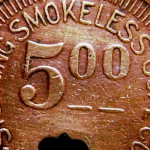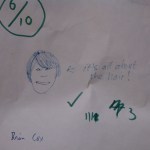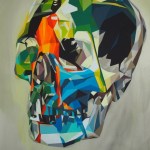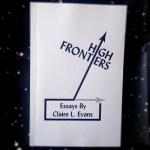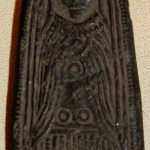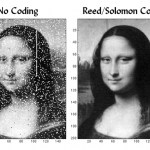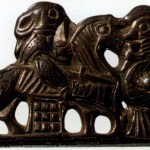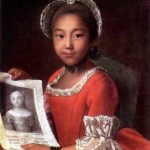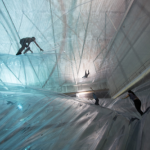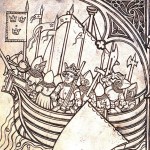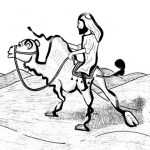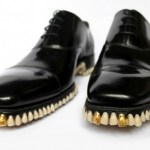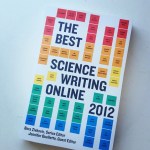Art
I was discussing SciArt on several occasions with different people recently and was fishing for a way to classify different SciArt in order to make a particular point - the point being that the type of SciArt I find most interesting and valuable is in the minority. Basically, it seems there are 3 (or maybe 4) general types of SciArt: informational, inspirational, and degradational. I should note that mostly I am talking about SciArt that is performed - mostly plays and movies. Although probably some variant of this can be applied to visual arts or music and such.
Degradational is when the…
"I don't understand how super mario can smash blocks with his head but dies when he touches a turtle." -Unknown
The past few weekends have been far too serious around the internet, and it's time to kick back and enjoy something nice and simple. I'd like to introduce you to the little-known indie band The Mountain Goats, who, along with Kaki King, sing a delightful song about feeling trapped and being rescued, called
Thank You Mario But Our Princess Is In Another Castle.
Of course, those of you who remember your old nintendo cartridges will know exactly where the song title comes from.
Image…
It was an unexpected journey, from the George W. Bush Shake, the Barack Obama Hug to the Harlem Shake.
Appreciation from the President of the United States is one of the highest honors any American can receive. No, it wasn't me, but the best part is that it was one of our students.
I have been very fortunate in my own education having learned from two mentors awarded the National Medal of Science (Prof. Tobin J. Marks and Prof. Stephen J. Lippard.) Each received a hearty handshake from President George W. Bush. Perhaps some of my work in their labs helped get them there, along with a…
This is an adaptation of my shortlisted entry to the 2013 Future of Money Design Award. The brief was to design a crime that would exist in a cashless economy. The judging took place at the Consult Hyperion Tomorrow's Transaction conference. I didn't win, but I enjoyed working on the idea and it was nice to make it to the final three, so I thought I'd share it here. Note that this is a work of fiction, although it contains many true elements.
EDIT: Since writing this, a lawsuit has been filed against a Pennsylvania McDonald's restaurant that insisted on paying employees via a fee-…
So last summer I ran a quiz at the Secret Garden Party festival in Cambridgeshire. For the picture round, teams had to submit their best drawing of hearthrob scientist Professor Brian Cox. Here are some of the entries.
Like Samson
"I have a drem"
Pie chart face: 50% smile
I think they got confused and drew Brian May, the other rockstar physicist.
Shirtless!
Just beautiful.
I'm rather taken by Tim Biskup's work, especially his skulls. I think this design appeared on a limited edition Poketo wallet (the only type I buy) some years back, but I missed out on getting one. For shame.
Artist:: Tim Biskup
For more of his latest work, see the Design Collector blog.
My paper on the re-use of Late Iron Age picture stones during that same period (mainly in late male graves) has been published in English and Swedish parallel versions of Gotländskt Arkiv 2012. That's the annual of the Gotland County Museum. Have a look! Questions and comments are most welcome.
Writing for the Internet is like yelling into the void: freeing, probably more than a little cathartic, but ultimately lonely. That's not to say that I haven't made profound connections out here, but like most writers I long for a little thing with my name on it that fits in the hand, that can be passed around and earmarked, tossed away and re-discovered.
Which is why I'm so pleased to announce the existence of precisely such a little thing: my brand-new collection of essays and arcana, High Frontiers, fresh from the presses of Publication Studio:
High Frontiers brings together…
Another one of the rare production dies for 6/7/8th century gold foil figures has come to light, again on Zealand! This is an unusual design depicting a lady from the front. She's wearing a long dress, a cloak and two bead strings. She seems to be cupping her hands around a ring at her abdomen. The rings on her dress hem are quite odd. Parallels to the general motif and design are known from Eketorp on Öland (a foil) and Sättuna in Östergötland (a die). Congratulations to detectorist Hans, and thanks for doing other folks with an interest in the past a big favour!
Update 4 Feb: Aard regular…
The cultural critic Walter Benjamin, in his seminal 1936 essay The Work of Art in the Age of Mechanical Reproduction, argued that the "aura" of a work of art, that sense of special awe and reverence we feel, being in its presence, isn't inherent to art itself. Rather, it's a side-effect of its exclusivity, restricted exhibition, authenticity, or perceived value. With the age of "mechanical reproduction" (i.e. printed copies, films, and photographs), that aura disappeared, freeing art from its ties to the bourgeoisie and allowing mass audiences to, in a sense, "own" the work too. Take the Mona…
Etymologically speaking, ”valkyrie” means ”chooser of the slain”. The job of these supernatural shield maidens in Norse mythology is to select who dies on the battlefield and guide their souls to Odin's manor, where they will spend the afterlife training for the Twilight of the Gods, the final battle against the forces of chaos. After each day's combat training, a mead-hall party with drink and reincarnated pork ensues, with the valkyries waiting the tables.
We have had very few period depictions of armed women. Instead scholars have applied the term “valkyrie” to a common Late Iron Age motif…
I found this lovely portrait on Wikipedia. 18th century portraits almost exclusively show people with European looks. But here a Russian painter has painted a Kalmyk girl in 1767. The Kalmyks are a Western Mongolian group living in south-west Russia. The girl looks just like Juniorette's buddy whose parents are from Afghanistan and Korea! This picture presses all my dad buttons.
Her name was Annushka and she was a serf and protegée of Countess Varvara Sheremeteva (later Countess Razumovsky). In the picture, the girl is holding a portrait of the Countess. The painter, Ivan Argunov, is a major…
Dressed in a leather jacket and black roll neck, Daniel Libeskind holds an air of affability that complements his passionate and lucid discussion about the importance of architecture in healing and rebuilding communities. Born into a Jewish family in Poland, he experienced life under the totalitarian Soviets before emigrating to New York, a narrative that makes him ideally suited to be the man who produced new visions for Germany and Poland after the fall of the Berlin wall through to the Freedom Tower which rose from the shadows of the World Trade Centre in New York City.…
From the moment he springs onto the stage, Tomás Saraceno's demeanour marks him out as an artist. Dressed in jeans and a hoodie, and wearing a scruffy beard, he stands in contrast to the parade of smartly-dressed academics that have so far made up the Falling Walls conference. Saraceno jokes that he has “about 400 slides” to get through in his 15 minute slot, yet it soon becomes clear that he really is going to try and get through them all.
Images whizz by as Saraceno hammers through his portfolio, and we’re flashed photos of abstract…
Check it out in full, for free!
Kim von Hackwitz on miniature Middle Neolithic battle axes around Lake Mälaren
Roger Wikell & Jörgen Johnsson on the re-discovery of a runic inscription on a cliff side near Stockholm
Herman Bengtsson & Christian Lovén on indications in Medieval church art about the contents of a lost longer version of the legend of Saint Eric
Jens Heimdahl on the medicinal use of henbane in 12th century Nyköping
Magnus Källström on the re-discovery of archive documentation of two lost rune stones near Uppsala
And an unusually pugnacious debate section
May K is a Russian artist living in Germany who draws cartoons based on the structure of proteins. Below is Bedouin Riding a Camel, which as it happens, is based on a protein found in a dromedary:
You can see more examples at her website, Protein-Art.com
"The artist is a receptacle for emotions that come from all over the place: from the sky, from the earth, from a scrap of paper, from a passing shape, from a spider's web." -Pablo Picasso
People find artistic inspiration from a plethora of different sources, ranging from the very complex to the extremely simple. This weekend, I'd like to share with you one of the most stunning, simple artistic constructions I've ever seen. For some reason, the song I'd like to share with you to take you through it is 1990s rapper Skee-Lo's take on a School House Rock classic,
The Tale of Mr. Morton.…
My Design Stories has the scoop on these handsome shoes:
British studio fantich and young have re-interepreted the humble dinner shoe by replacing a regular rubber sole with hundreds of dentures. The ‘apex predator shoe’ transforms the elegant savile row oxford shoe, inlaying 1050 fake teeth and accompanies an entire suit made of human hair and glass eyes.
As the citizen on dirty.ru who posted this image put it: "What is there else to say?".
So here's a crude attempt at something that's been on my mind for over a year now. I thought it'd be interesting to represent the elemental composition of different objects using a three-dimensional periodic table. So, for example, here's the elemental composition of the human body:
It's not a great mockup, but it's the best I could do with the tools and skills available to me. I made the chart in Excel using data from Wikipedia, and manually coloured all those little cells. When it came time to do the lettering I really couldn't figure out a way to do it that didn't involve scissors and…
I've been practicing little idiosyncratic rituals on this corner of the web for years: learn something new, obsessively research, get lost in the idea, scribble, converse endlessly, then write. This blog, Universe, has never been about garnering hits or materializing an audience because, for me, thinking and writing about science is a personal tic. I can't help but yell into the void; I understand science as a poetic language for explaining reality, and when I see changes in that language all I want to do is unfasten myself into them.
I definitely don't seek any form of recognition for what…
